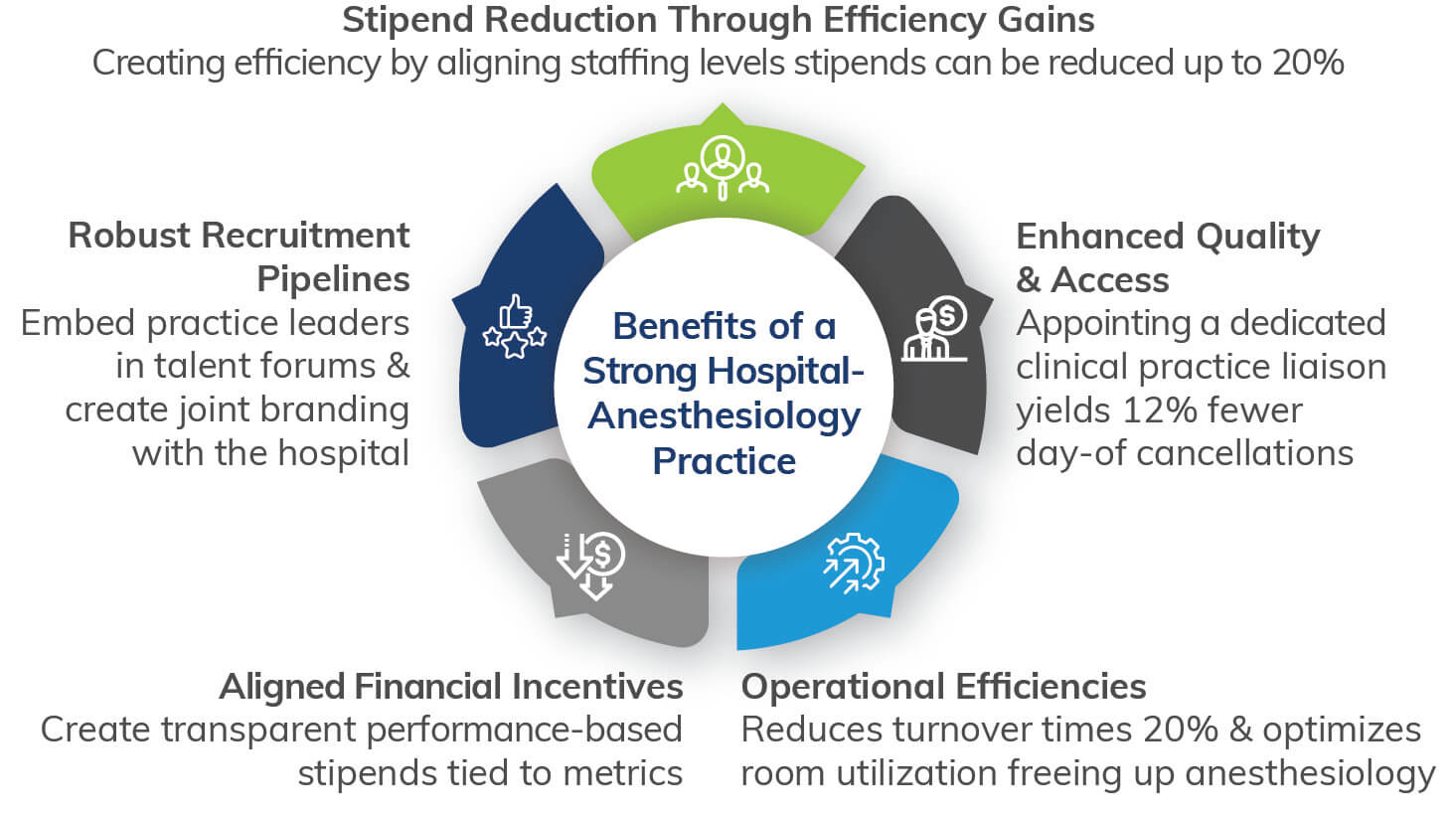Executive Summary
- Enhanced Recruitment:
Deepening relationships with anesthesiology practices strengthens recruitment pipelines, reducing vacancy risk and locum dependence. - Cost Containment:
Collaboration on workflow efficiencies and scheduling can lower stipend spend by up to 20%, curbing overall anesthesiology expense1. - Operational Efficiency:
Joint process‐improvement initiatives accelerate first case on‐time starts by 15% and cut day‐of cancellations by 12%, boosting perioperative throughput2. Additionally, these improvements enhance access for surgeons and proceduralists, enabling some facilities to add 2-3 cases per day in certain instances. - Aligned Incentive:
Shared performance metrics reward both hospitals and practices for volume growth, quality care, and mutual sustainability. - Practical Toolkit:
Understand 12 targeted negotiation questions to guide hospitals and practices in designing contracts that foster recruitment, drive efficiencies, and manage costs.
The Challenge: Rising Costs and Staffing Pressures
Hospitals face escalating anesthesiology expenses and a growing provider shortage.
Major pain points include:

- Ballooning Stipends: year‐over‐year stipend increases of 20-40% destabilize budgets and erode margins3.
- Recruitment Gaps: national radiologist and anesthesiologist shortages—projected to reach 12-17% FTE shortfalls—force hospitals into expensive locum tenens arrangements4.
- Throughput Slowdowns: inconsistent on‐site coverage leads to delayed case starts and higher rates of rescheduling or case cancelations, which impedes surgical volume, growth and revenue.
Misalignment with anesthesia groups also contributes to shortfalls in longer-term procedural care strategies. Without a good partner, right surgery, right place, right time strategies are difficult to execute.
Benefits of Strengthening Practice Relationships
Proactively Partnering with Anesthesiology Groups Delivers Multiple Incentives:
- Robust Recruitment Pipelines: Embedding practice leaders in hospital talent forums and offering joint branding for recruitment accelerates filling open positions. Practices gain visibility to promising candidates, and hospitals secure committed providers7.
- Operational Efficiencies: Co-designing standard workflows—such as shared block scheduling protocols and real-time case-flow dashboards—reduces turnover times by 20% and optimizes room utilization. This frees anesthesiologists to handle more cases, assists in throughput, and improves bed management, augmenting patient care processes8.
- Stipend Reduction Through Efficiency Gains: By aligning staffing levels to actual volume and eliminating idle block time, hospitals and practices have jointly reduced annual stipend obligations by up to 20%. Those savings can be reinvested in recruitment incentives or quality programs9.
- Aligned Financial Incentives: Moving from flat stipends to transparent performance-based payments—tied to metrics such as first-case on-time starts (target ≥70%) and block utilization (target 75-80%)—encourages both parties to optimize throughput, uphold quality standards, and maintain more sustainable staffing relationships10.
- Enhanced Quality & Access: Appointing a dedicated clinical practice liaison (an anesthesiologist or CRNA) to work alongside OR leadership improves communication, smooths scheduling conflicts, and ensures timely coverage. This partnership approach yields 12% fewer day-of cancellations and bolsters patient satisfaction11.
Proven Results from Collaborative Initiatives
Several institutions illustrate the power of strong hospital-practice alignment:
- Case Study A: A mid‐sized health system partnered with its anesthesiology group to standardize block release windows and share daily scheduling data. Within 9 months, stipends fell by 18% and first case starts improved by 17%2.
- Case Study B: By jointly funding a locum backup pool rather than individual call stipends, one system cut locum costs by 25% and filled 90% of overnight calls with on‐site practitioners5.
- Case Study C: Implementing a shared onboarding and continuing education subsidy program attracted 30% more applicants to anesthesiology openings over two recruitment cycles, reducing vacancy rates from 15%-5%6.
- Case Study D: Transitioning to a shift-based anesthesia work model, with overtime pay and CRNA care team integration, stabilized physician schedules, reduced burnout, improved recruitment, and strengthened collaboration across the surgical team amid rapid growth at a large cancer center12.
- Case Study E: A large Midwest health system with more than 485 beds and 33 operating rooms enhanced operational efficiency, increased surgical volume, and identified $8 million in savings by refining staffing models, revising agreements, and establishing a new governance structure, while strengthening communication and collaboration across staff and providers13.
Understanding Strengths, Weaknesses, Opportunities, and Threats (SWOT) for Anesthesiology Practice Alignment Strengths
- Strengths
- Direct engagement fosters mutual accountability
- Incentive alignment drives both volume growth and cost containment
- Weaknesses
- Requires initial resource investment to map workflows and build data‐sharing infrastructure
- Cultural buy‐in needed from both hospital and practice leadership
- Opportunities
- Joint marketing for recruitment amplifies talent‐attraction efforts
- Continuous improvement projects can expand into interventional and imaging‐guided procedural domains
- Threats
- Unchecked stipend creep without clear performance thresholds can reduce transparency for fair compensation and erode trust in both parties’ values and strategies
- Persistent national provider shortages may limit the pool despite recruitment efforts
Negotiation Toolkit: 12 Essential Questions
- What have historic block utilization and first case on‐time rates been, and how can we improve these together?
- Which process‐improvement or quality-related initiatives (e.g., turnover reduction, blood utilization, etc.) would you prioritize, and how should gains translate into cost sharing?
- Can we establish volume‐flexible payment tiers tied to procedural growth in key service lines?
- How can we jointly brand and market employment opportunities to enhance recruitment pipelines?
- What real‐time scheduling and throughput dashboards can we share to identify inefficiencies?
- How should we structure on‐call and locum arrangements to minimize total coverage expenses?
- What career‐development and continuing education programs can we co‐fund to improve retention?
- What performance (or quality) metrics (e.g., <1% cancellations) will trigger bonus or penalty adjustments?
- How can we mutually agree on incremental, necessary stipend changes without going back to the bargaining table?
- What shared governance or liaison roles will ensure continuous collaboration and conflict resolution?
- How will liability, credentialing, and compliance responsibilities be allocated and managed?
- What provisions should account for evolving trends (e.g., AI adoption, tele‐services, or regulatory shifts) in our contract?
Conclusion
In today’s strained anesthesiology landscape, hospitals cannot afford reactive stipend increases or one-off renegotiations. By forging deep, collaborative partnerships with anesthesiology practices, anchored in shared data, aligned incentives, and joint recruitment strategies, institutions can secure stable coverage, contain costs, and enhance perioperative throughput. This white paper’s toolkit empowers hospitals to navigate complex negotiations, ensuring that both parties thrive and, ultimately, that patient care remains uninterrupted and of the highest quality.
References
- Journal of Healthcare Finance. Incentive-Based Contracting in Anesthesia. 2024.
- Journal of Clinical Anesthesia. Impact of Shared Scheduling on Perioperative Throughput. 2023.
- Becker’s Hospital Review. Trends in Anesthesia Stipends and Contract Models. May 2024.
- American Society of Anesthesiologists. Practice Management and Governance Guidelines. 2025.
- Healthcare Financial Management Association. Locum Tenens Cost Analysis. 2024.
- Anesthesia & Analgesia. Recruitment and Retention Strategies in Anesthesiology. 2023.
- American College of Healthcare Executives. Recruitment acceleration through hospital-practice partnerships: 2022 workforce survey. 2023.
- Journal of Healthcare Engineering. Shared scheduling protocols and real-time dashboards: Reducing OR turnover times in multi-center study. 2023.
- Healthcare Financial Management Association. Utilization-based stipend models: Cost savings and strategic reinvestment. 2024.
- Journal of Clinical Anesthesia. Performance-based incentives in anesthesia: Effects on first-case on-time starts and block utilization. 2023.
- Annals of Surgery. Impact of perioperative liaison roles on day-of cancellations and patient satisfaction. 2022.
- SurgicalDirections.com. Case Study: Locum Backup Pool Model Reduces Locum Costs and Boosts On-Site Coverage. May 2024.
- SurgicalDirections.com. Case Study: Onboarding & CME Subsidy Initiative Accelerates Anesthesiology Recruitment. April 2024.




